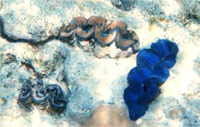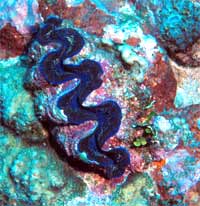|

Tissue habitat: Stationary in adulthood, the creature's mantle tissues act as a habitat for the symbiotic single-celled dinoflagellate algae (xooxanthellae) from which it gets its nutrition. By day, the clam spreads out its mantle tissue so that the algae receive the sunlight they need to photosynthesize.
 Misunderstood giant: As is often the case with uncharacteristically large species, the giant clam has been historically misunderstood. Misunderstood giant: As is often the case with uncharacteristically large species, the giant clam has been historically misunderstood.
Man-eating clam? Known in times past as the killer clam or man-eating clam, reputable scientific and technical manuals once claimed that the great mollusc had caused deaths; versions of the U.S. Navy Diving Manual even gave detailed instructions for releasing  oneself from its grasp by severing the adductor muscles used to close its shell. oneself from its grasp by severing the adductor muscles used to close its shell.
Strong grip is defensive, not offensive: Today, it is generally acknowledged that the giant clam is neither aggressive nor particularly dangerous; while it is certainly capable of holding one fast in its grip, the shell's closing action is actually a defensive response, and far too slow to pose any reasonable threat. No account of a human becoming trapped in this manner has ever been substantiated.
All text is available under the terms
of the GNU Free Documentation License
|